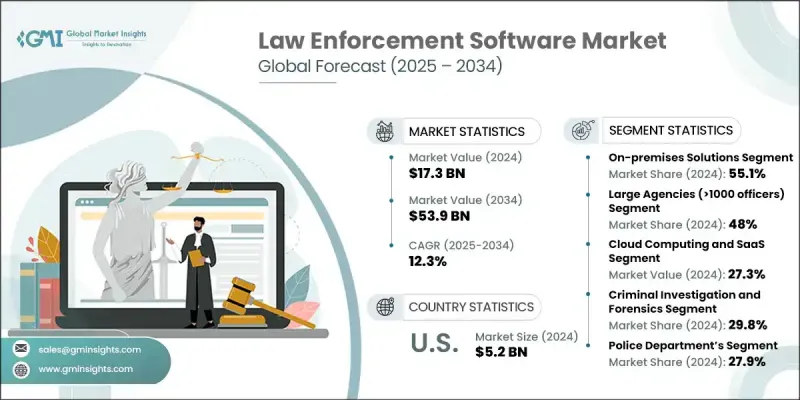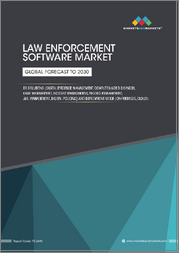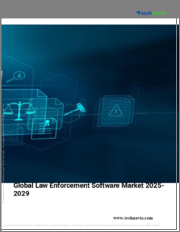
|
시장보고서
상품코드
1822659
법률 집행 소프트웨어 시장 : 기회, 성장 촉진요인, 산업 동향 분석 및 예측(2025-2034년)Law Enforcement Software Market Opportunity, Growth Drivers, Industry Trend Analysis, and Forecast 2025 - 2034 |
||||||
세계의 법률 집행 소프트웨어 시장 규모는 2024년에 173억 달러로 평가되었고, CAGR은 12.3%를 나타낼 것으로 예측되며 2034년에 539억 달러에 이를 전망입니다.

이러한 상승 추세는 전 세계 법률 집행 운영 전반에 걸쳐 인공지능(AI), 클라우드 컴퓨팅 및 데이터 분석의 채택 증가에 의해 촉진되고 있습니다. 증가하는 위협, 진화하는 범죄 기술 및 원활한 디지털 치안에 대한 수요는 기관들이 안전하고 상호 운용 가능하며 지능적인 소프트웨어 플랫폼을 구현하도록 촉구하고 있습니다. 이러한 공구들은 예측 감시, 실시간 모니터링 및 중앙 집중식 사건 관리와 같은 기능을 뒷받침합니다. 관할 구역 전반에 걸쳐 디지털 전환이 가속화됨에 따라, 법률 집행 기관들은 대응 능력을 향상시키고 운영 효율성을 개선하기 위해 인프라를 신속하게 현대화하고 있습니다. 클라우드 기반 생태계, 자동화 공구, 실시간 정보 시스템은 다양한 규모와 운영 범위의 기관 전반에 걸쳐 소프트웨어 수요를 촉진하는 핵심 역할을 수행합니다.
| 시장 범위 | |
|---|---|
| 시작 연도 | 2024년 |
| 예측 연도 | 2025-2034년 |
| 시장 규모 | 173억 달러 |
| 예측 금액 | 539억 달러 |
| CAGR | 12.3% |
통합 디지털 증거 추적, AI 기반 의사 결정 지원, 실시간 운영 대시보드와 같은 가치 중심 기능은 이제 최근 법률 집행 시스템의 필수 컴포넌트로 간주됩니다. 이러한 변화는 더 스마트하고 적응력이 뛰어난 공공 안전 기술로의 전환을 반영합니다. 북미는 고급 IT 인프라와 재정적 지원이 충분한 경찰 기관 덕분에 전개 및 투자 측면에서 선두를 기록하고 있습니다. 반면 아시아태평양 지역은 국가들이 디지털 투자를 늘리고 스마트 경찰 활동이 확대됨에 따라 빠르게 성장의 중심지로 부상하고 있습니다. 해당 지역 국가들은 공공 안전 관리를 혁신하기 위해 AI 기반 범죄 모니터링 시스템과 클라우드 우선 전략을 도입하고 있습니다.
온프레미스 전개 모델 부문은 2024년 55.1%의 점유율을 기록했으며, 2034년까지 연평균 11%의 성장률을 보일 것으로 전망됩니다. 법률 집행 기관들은 데이터 주권 유지, 기존 플랫폼과의 통합, 엄격한 사이버 보안 기준 충족을 위해 여전히 현지 호스팅 시스템에 크게 의존하고 있습니다. 이러한 시스템에는 사건 문서화 소프트웨어, 내부 디지털 저장 솔루션, 현지화된 정보 관리 공구가 포함되며, 모두 민감한 환경에서의 일상 운영에 여전히 필수적입니다.
수사기관 규모 측면에서 1,000명 이상의 경찰관을 보유한 기관은 2024년 48%의 점유율을 기록했으며, 2034년까지 연평균 성장률(CAGR) 10.9%로 성장할 것으로 예상됩니다. 이러한 대규모 기관들은 중앙 집중식 정보 공유, 포괄적인 디지털 포렌식, 확장 가능한 지휘 플랫폼을 가능하게 하는 강력한 소프트웨어 솔루션을 우선시합니다. AI 기반 데이터 분석 및 통합 통신 시스템에 대한 의존도 증가는 이 부문에서 소프트웨어 수요를 더욱 높입니다.
미국의 법률 집행 소프트웨어 시장은 2024년 81.6%의 점유율을 기록하며 52억 달러를 기록했습니다. 연방, 주, 지방 부서에 걸친 광범위한 전개로 미국은 법률 집행 소프트웨어 분야의 혁신과 구현에서 선두를 유지하고 있습니다. 이 나라는 성숙한 디지털 인프라, 지속적인 자금 지원, 공공 안전 네트워크에서의 클라우드 및 AI 기술의 대규모 채택으로 혜택을 받고 있습니다.
세계의 법률 집행 소프트웨어 시장에 영향을 미치는 주요 진출기업으로는 IBM, Tyler Technologies, Motorola Solutions, Axon Enterprise, NEC, Nice, Hexagon 등이 있습니다. 법률 집행 소프트웨어 시장 주요 기업들은 혁신, 확장성, 전략적 협력을 통해 입지를 강화하는 데 주력하고 있습니다. 많은 기업들이 예측 분석, 사건 대응, 범죄 패턴 식별 능력을 향상시키기 위해 플랫폼에 인공지능(AI)과 머신 러닝을 통합하고 있습니다. 또한 기업들은 소규모 및 대규모 법 집행 기관의 고유한 운영 요구를 충족시키기 위해 모듈형 제품군을 확대되고 있습니다. 또 다른 초점은 클라우드 전환에 있습니다. 기업들은 시스템 민첩성을 높이고 유지보수 비용을 감축하기 위해 하이브리드 및 완전 클라우드 솔루션을 점점 더 많이 제공하고 있습니다.
목차
제1장 조사 방법과 범위
제2장 주요 요약
제3장 업계 인사이트
- 생태계 분석
- 공급자의 상황
- 이익률 분석
- 비용 구조
- 각 단계에서의 부가가치
- 밸류체인에 영향을 주는 요인
- 혁신
- 업계에 미치는 영향요인
- 성장 촉진요인
- 법률 집행 기관의 급속한 디지털 전환
- 규제 및 규정 준수 의무
- 실시간 정보 및 예측형 치안에 대한 수요 증가
- 정부의 대처와 인센티브
- 업계의 잠재적 위험 및 과제
- 데이터 개인정보 보호 및 보안 문제
- 레거시 시스템 통합 과제
- 시장 기회
- 클라우드 기반 및 AI 대응 소프트웨어 솔루션의 성장
- 신흥 시장 진출(아시아태평양, 라틴아메리카)
- 부가가치 서비스와 지능형 소프트웨어 생태계
- 기관간 데이터 공유 및 상호 운용성 플랫폼
- 성장 촉진요인
- 성장 가능성 분석
- 규제 상황
- 북미
- 유럽
- 아시아태평양
- 라틴아메리카
- 중동 및 아프리카
- Porter's Five Forces 분석
- PESTEL 분석
- 기술과 혁신 상황
- 현재 기술 동향
- 신흥 기술
- 스킬 갭 분석과 인재 개발
- 현재 데이터 센터 기술 인력 부족 평가
- 미래 인력 요구 사항
- 재교육 및 기술 향상 계획
- 기업연수와 개인인정
- 학술기관과의 제휴
- 정부 연수 프로그램
- 데이터 센터 관리 분야의 경력 경로 개발
- 가격 분석과 비용 모델
- 인프라 비용 구조 분석
- 공급업체 가격 전략
- 구독 모델과 소비 기반 모델
- 코로케이션 요금 패키지
- 전력 사용 비용의 내역
- 투자의 ROI 평가
- 지역 간의 비용 비교
- 코스트 내역 분석
- 특허 분석
- 지속가능성과 환경 측면
- 지속가능한 관행
- 폐기물 감축 전략
- 생산 과정의 에너지 효율성
- 환경 친화적인 노력
- 탄소발자국의 고려
- 이용 사례
- 사이버 보안 및 데이터 보호 분석
- 상호 운용성과 표준 분석
- 교육 및 변경 관리
- 디지털 전환의 영향 분석
- 새로운 이용 사례와 용도
- 최상의 시나리오
제4장 경쟁 구도
- 소개
- 기업의 시장 점유율 분석
- 북미
- 유럽
- 아시아태평양
- 라틴아메리카
- 중동 및 아프리카
- 주요 시장 기업의 경쟁 분석
- 경쟁 포지셔닝 매트릭스
- 전략적 전망 매트릭스
- 주요 발전
- 합병과 인수
- 파트너십 및 협업
- 신제품 발매
- 확장계획과 자금조달
제5장 시장 추계 및 예측 : 컴포넌트별(2021-2034년)
- 주요 동향
- 기록 관리 시스템(RMS)
- 컴퓨터 지원 출동(CAD) 시스템
- 증거 관리 시스템
- 사건 관리 소프트웨어
- 범죄 분석 및 정보 소프트웨어
- 모바일 경찰 소프트웨어
- 교육 및 시뮬레이션 소프트웨어
- 기타
제6장 시장 추계 및 예측 : 도입 모델별(2021-2034년)
- 주요 동향
- 온프레미스 솔루션
- 클라우드 기반 솔루션
- 하이브리드 전개 모델
제7장 시장 추계 및 예측 : 기술별(2021-2034년)
- 주요 동향
- 클라우드 컴퓨팅 및 SaaS
- 인공지능 및 머신러닝
- 모바일 및 무선 기술
- 블록체인 및 분산 원장
- IoT 및 접속 디바이스
- 생체 인증 및 인식 기술
제8장 시장 추계 및 예측 : 용도별(2021-2034년)
- 주요 동향
- 범죄수사와 법의학
- 범죄 예방과 순찰
- 교통관리와 단속
- 긴급 대응과 파견
- 법원과 법적 절차
- 교정과 갱생
제9장 시장 추계 및 예측 : 최종 용도별(2021-2034년)
- 주요 동향
- 경찰서
- 연방법률 집행기관
- 보안관 사무소
- 기타 법률 집행 기관
- 법원과 사법제도
제10장 시장 추계 및 예측 : 통합 레벨별(2021-2034년)
- 주요 동향
- 완전 통합 플랫폼
- 독립형 솔루션
- 부분 통합 시스템
- 기업 전체의 생태계
제11장 시장 추계 및 예측 : 조직 규모별(2021-2034년)
- 주요 동향
- 대규모 기관(직원 1,000명 초과)
- 중규모 기관(직원수 100-1000명)
- 소규모 기관(직원수 100명 미만)
제12장 시장 추계 및 예측 : 지역별(2021-2034년)
- 주요 동향
- 북미
- 미국
- 캐나다
- 유럽
- 영국
- 독일
- 프랑스
- 이탈리아
- 스페인
- 러시아
- 북유럽 국가
- 아시아태평양
- 중국
- 인도
- 일본
- 호주
- 한국
- 동남아시아
- 라틴아메리카
- 브라질
- 멕시코
- 아르헨티나
- 중동 및 아프리카
- 남아프리카
- 사우디아라비아
- 아랍에미리트(UAE)
제13장 기업 프로파일
- 세계 기업
- Hexagon
- IBM
- Motorola Solutions
- NEC
- Nice
- Palantir Technologies
- Tyler Technologies
- 지역 기업
- Axon Enterprise
- Cellebrite DI
- Coban Technologies
- CODY Systems
- Esri
- Forensic Logic
- Genetec
- Mark43
- Numerica
- Omnigo Software
- Resolver
- ShotSpotter
- Tribridge
The Global Law Enforcement Software Market was valued at USD 17.3 billion in 2024 and is estimated to grow at a CAGR of 12.3% to reach USD 53.9 billion by 2034.

This upward trajectory is driven by increased adoption of AI, cloud computing, and data analytics across law enforcement operations worldwide. Rising threats, evolving crime techniques, and demand for seamless digital policing are pushing agencies to implement secure, interoperable, and intelligent software platforms. These tools support functions like predictive surveillance, real-time monitoring, and centralized case management. With digital transformation accelerating across jurisdictions, law enforcement agencies are rapidly modernizing infrastructure to enhance response capabilities and improve operational efficiency. Cloud-based ecosystems, automation tools, and real-time intelligence systems play a crucial role in driving software demand across various agency sizes and operational scopes.
| Market Scope | |
|---|---|
| Start Year | 2024 |
| Forecast Year | 2025-2034 |
| Start Value | $17.3 Billion |
| Forecast Value | $53.9 Billion |
| CAGR | 12.3% |
Value-based features like integrated digital evidence tracking, AI-driven decision support, and real-time operational dashboards are now considered essential components of modern law enforcement systems. This shift reflects a move toward smarter and more adaptive public safety technologies. North America holds the top spot in deployment and investment, owing to advanced IT infrastructure and well-funded policing bodies. On the other hand, the Asia-Pacific region is fast becoming a hotspot for growth, as countries increase digital investments and expand smart policing efforts. Nations across the region are adopting AI-based crime monitoring systems and cloud-first initiatives to transform public safety management.
The on-premises deployment models segment held 55.1% share in 2024 and is forecasted to grow at a CAGR of 11% through 2034. Law enforcement organizations continue to rely heavily on locally hosted systems to maintain data sovereignty, integrate with legacy platforms, and meet strict cybersecurity standards. These systems encompass case documentation software, in-house digital storage solutions, and localized intelligence management tools, all of which remain vital to day-to-day operations in sensitive environments.
In terms of agency size, organizations with over 1,000 officers held a 48% share in 2024 and are likely to grow at a CAGR of 10.9% through 2034. These large institutions prioritize robust software solutions that enable centralized intelligence sharing, comprehensive digital forensics, and scalable command platforms. Their growing reliance on AI-powered data analytics and integrated communication systems further elevates software demand in this segment.
United States Law Enforcement Software Market held an 81.6% share and generated USD 5.2 billion in 2024. With extensive deployments across federal, state, and local departments, the US remains at the forefront of innovation and implementation in law enforcement software. The country benefits from mature digital infrastructure, consistent funding, and wide-scale adoption of cloud and AI technologies in public safety networks.
Major participants influencing the Global Law Enforcement Software Market include IBM, Tyler Technologies, Motorola Solutions, Axon Enterprise, NEC, Nice, and Hexagon. Key players in the law enforcement software market are focusing on innovation, scalability, and strategic collaboration to strengthen their positions. Many are integrating AI and machine learning into their platforms to enhance predictive analysis, incident response, and crime pattern identification. Companies are also expanding modular offerings to cater to the unique operational needs of both small and large law enforcement bodies. Another focus is on cloud transformation-firms are increasingly offering hybrid and full cloud solutions to improve system agility and reduce maintenance overhead.
Table of Contents
Chapter 1 Methodology & Scope
- 1.1 Market scope and definition
- 1.2 Research design
- 1.2.1 Research approach
- 1.2.2 Data collection methods
- 1.3 Data mining sources
- 1.3.1 Global
- 1.3.2 Regional/Country
- 1.4 Base estimates and calculations
- 1.4.1 Base year calculation
- 1.4.2 Key trends for market estimation
- 1.5 Primary research and validation
- 1.5.1 Primary sources
- 1.6 Forecast model
- 1.7 Research assumptions and limitations
Chapter 2 Executive Summary
- 2.1 Industry 360° synopsis, 2021 - 2034
- 2.2 Key market trends
- 2.2.1 Regional
- 2.2.2 Component
- 2.2.3 Deployment Model
- 2.2.4 Technology
- 2.2.5 End Use
- 2.2.6 Application
- 2.2.7 Integration Level
- 2.2.8 Organization Size
- 2.3 TAM Analysis, 2025-2034
- 2.4 CXO perspectives: Strategic imperatives
- 2.4.1 Executive decision points
- 2.4.2 Critical success factors
- 2.5 Future outlook and strategic recommendations
Chapter 3 Industry Insights
- 3.1 Industry ecosystem analysis
- 3.1.1 Supplier landscape
- 3.1.2 Profit margin analysis
- 3.1.3 Cost structure
- 3.1.4 Value addition at each stage
- 3.1.5 Factor affecting the value chain
- 3.1.6 Disruptions
- 3.2 Industry impact forces
- 3.2.1 Growth drivers
- 3.2.1.1 Rapid Digital Transformation of Law Enforcement Agencies
- 3.2.1.2 Regulatory and Compliance Mandates
- 3.2.1.3 Rising Demand for Real-Time Intelligence and Predictive Policing
- 3.2.1.4 Government Initiatives and Incentives
- 3.2.2 Industry pitfalls and challenges
- 3.2.2.1 Data Privacy and Security Concerns
- 3.2.2.2 Legacy System Integration Challenges
- 3.2.3 Market opportunities
- 3.2.3.1 Growth in Cloud-Based and AI-Enabled Software Solutions
- 3.2.3.2 Expansion in Emerging Markets (Asia-Pacific, Latin America)
- 3.2.3.3 Value-Added Services and Intelligent Software Ecosystems
- 3.2.3.4 Cross-Agency Data Sharing and Interoperability Platforms
- 3.2.1 Growth drivers
- 3.3 Growth potential analysis
- 3.4 Regulatory landscape
- 3.4.1 North America
- 3.4.2 Europe
- 3.4.3 Asia Pacific
- 3.4.4 Latin America
- 3.4.5 Middle East & Africa
- 3.5 Porter's analysis
- 3.6 PESTEL analysis
- 3.7 Technology and Innovation landscape
- 3.7.1 Current technological trends
- 3.7.2 Emerging technologies
- 3.8 Skills gap analysis and workforce development
- 3.8.1 Current data center skills shortage assessment
- 3.8.2 Future workforce requirements
- 3.8.3 Reskilling and upskilling initiatives
- 3.8.4 Corporate training vs individual certification
- 3.8.5 Academic institution partnerships
- 3.8.6 Government training programs
- 3.8.7 Career path development in data center management
- 3.9 Pricing analysis and cost models
- 3.9.1 Infrastructure cost structure analysis
- 3.9.2 Vendor pricing strategies
- 3.9.3 Subscription vs consumption-based models
- 3.9.4 Colocation pricing packages
- 3.9.5 Power usage cost breakdown
- 3.9.6 ROI assessment for investment
- 3.9.7 Cost comparison across regions
- 3.10 Cost breakdown analysis
- 3.11 Patent analysis
- 3.12 Sustainability and environmental aspects
- 3.12.1 Sustainable practices
- 3.12.2 Waste reduction strategies
- 3.12.3 Energy efficiency in production
- 3.12.4 Eco-friendly Initiatives
- 3.12.5 Carbon footprint considerations
- 3.13 Use cases
- 3.13.1 Cybersecurity and Data Protection Analysis
- 3.13.2 Interoperability and Standards Analysis
- 3.13.3 Training and Change Management
- 3.13.4 Digital Transformation Impact Analysis
- 3.13.5 Emerging Use Cases and Applications
- 3.14 Best-case scenario
Chapter 4 Competitive Landscape, 2024
- 4.1 Introduction
- 4.2 Company market share analysis
- 4.2.1 North America
- 4.2.2 Europe
- 4.2.3 Asia Pacific
- 4.2.4 LATAM
- 4.2.5 MEA
- 4.3 Competitive analysis of major market players
- 4.4 Competitive positioning matrix
- 4.5 Strategic outlook matrix
- 4.6 Key developments
- 4.6.1 Mergers & acquisitions
- 4.6.2 Partnerships & collaborations
- 4.6.3 New Product Launches
- 4.6.4 Expansion Plans and funding
Chapter 5 Market Estimates & Forecast, By Component, 2021 - 2034 ($Bn)
- 5.1 Key trends
- 5.2 Records management systems (RMS)
- 5.3 Computer-aided dispatch (CAD) systems
- 5.4 Evidence management systems
- 5.5 Case management software
- 5.6 Crime analytics and intelligence software
- 5.7 Mobile police software
- 5.8 Training and simulation software
- 5.9 Others
Chapter 6 Market Estimates & Forecast, By Deployment Model, 2021 - 2034 ($Bn)
- 6.1 Key trends
- 6.2 On-premises solutions
- 6.3 Cloud-based solutions
- 6.4 Hybrid deployment models
Chapter 7 Market Estimates & Forecast, By Technology, 2021 - 2034 ($Bn)
- 7.1 Key trends
- 7.2 Cloud computing and SaaS
- 7.3 Artificial intelligence and machine learning
- 7.4 Mobile and wireless technologies
- 7.5 Blockchain and distributed ledger
- 7.6 IoT and connected devices
- 7.7 Biometric and recognition technologies
Chapter 8 Market Estimates & Forecast, By Application, 2021 - 2034 ($Bn)
- 8.1 Key trends
- 8.2 Criminal investigation and forensics
- 8.3 Crime prevention and patrol
- 8.4 Traffic management and enforcement
- 8.5 Emergency response and dispatch
- 8.6 Court and legal proceedings
- 8.7 Corrections and rehabilitation
Chapter 9 Market Estimates & Forecast, By End Use, 2021 - 2034 ($Bn)
- 9.1 Key trends
- 9.2 Police departments
- 9.3 Federal law enforcement agencies
- 9.4 Sheriff's offices
- 9.5 Other law enforcement agencies
- 9.6 Courts and justice system
Chapter 10 Market Estimates & Forecast, By Integration Level, 2021 - 2034 ($Bn)
- 10.1 Key trends
- 10.2 Fully integrated platforms
- 10.3 Standalone solutions
- 10.4 Partially integrated systems
- 10.5 Enterprise-wide ecosystems
Chapter 11 Market Estimates & Forecast, By Organization Size, 2021 - 2034 ($Bn)
- 11.1 Key trends
- 11.2 Large agencies (>1000 Officers)
- 11.3 Medium agencies (100-1000 Officers)
- 11.4 Small agencies (<100 Officers)
Chapter 12 Market Estimates & Forecast, By Region, 2021 - 2034 ($Bn)
- 12.1 Key trends
- 12.2 North America
- 12.2.1 US
- 12.2.2 Canada
- 12.3 Europe
- 12.3.1 UK
- 12.3.2 Germany
- 12.3.3 France
- 12.3.4 Italy
- 12.3.5 Spain
- 12.3.6 Russia
- 12.3.7 Nordics
- 12.4 Asia Pacific
- 12.4.1 China
- 12.4.2 India
- 12.4.3 Japan
- 12.4.4 Australia
- 12.4.5 South Korea
- 12.4.6 Southeast Asia
- 12.5 Latin America
- 12.5.1 Brazil
- 12.5.2 Mexico
- 12.5.3 Argentina
- 12.6 MEA
- 12.6.1 South Africa
- 12.6.2 Saudi Arabia
- 12.6.3 UAE
Chapter 13 Company Profiles
- 13.1 Global Players
- 13.1.1 Hexagon
- 13.1.2 IBM
- 13.1.3 Motorola Solutions
- 13.1.4 NEC
- 13.1.5 Nice
- 13.1.6 Palantir Technologies
- 13.1.7 Tyler Technologies
- 13.2 Regional Players
- 13.2.1 Axon Enterprise
- 13.2.2 Cellebrite DI
- 13.2.3 Coban Technologies
- 13.2.4 CODY Systems
- 13.2.5 Esri
- 13.2.6 Forensic Logic
- 13.2.7 Genetec
- 13.2.8 Mark43
- 13.2.9 Numerica
- 13.2.10 Omnigo Software
- 13.2.11 Resolver
- 13.2.12 ShotSpotter
- 13.2.13 Tribridge













